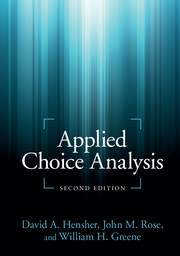Book contents
- Frontmatter
- Contents
- List of Figures
- List of Tables
- Preface
- Part I Getting started
- 1 In the beginning
- 2 Choosing
- 3 Choice and utility
- 4 Families of discrete choice models
- 5 Estimating discrete choice models
- 6 Experimental design and choice experiments
- 7 Statistical inference
- 8 Other matters that analysts often inquire about
- Part II Software and data
- Part III The suite of choice models
- Part IV Advanced topics
- Select glossary
- References
- Index
7 - Statistical inference
from Part I - Getting started
Published online by Cambridge University Press: 05 June 2015
- Frontmatter
- Contents
- List of Figures
- List of Tables
- Preface
- Part I Getting started
- 1 In the beginning
- 2 Choosing
- 3 Choice and utility
- 4 Families of discrete choice models
- 5 Estimating discrete choice models
- 6 Experimental design and choice experiments
- 7 Statistical inference
- 8 Other matters that analysts often inquire about
- Part II Software and data
- Part III The suite of choice models
- Part IV Advanced topics
- Select glossary
- References
- Index
Summary
Introduction
This chapter will discuss some issues in statistical inference in the analysis of choice models. We are concerned with two kinds of computations, hypothesis tests and variance estimation. To illustrate the analyses, we will work through an example based on a revealed preference (RP) data set. In this chapter, we present syntax and output generated using Nlogit to demonstrate the concepts covered. The syntax and output is, for the more familiar reader, largely self-explanatory; however, for the less familiar reader, we refer you to Chapter 11, which you may wish to read before going further. The multinomial logit model for the study is shown in the following Nlogit set up which gives the utility functions for four travel modes: bus, train, busway and car, respectively:
;Model:
u(bs) = bs + actpt*act + invcpt*invc + invtpt*invt2 + egtpt*egt + trpt*trnf /
u(tn) = tn + actpt*act + invcpt*invc + invtpt*invt2 + egtpt*egt + trpt*trnf /
u(bw) = bw + actpt*act + invcpt*invc + invtpt*invt2 + egtpt*egt + trpt*trnf /
u(cr) =TC*TC + PC*PC + invtcar*invt + egtcar*egt
The attributes are act = access time, invc = in vehicle cost, invt2 = in vehicle time, egt = egress time, trnf = transfer wait time, tc = toll cost, pc = parking cost, and invt = in vehicle time for car. Where a particular example uses a method given in more detail in later chapters, we will provide a cross-reference.
Information
- Type
- Chapter
- Information
- Applied Choice Analysis , pp. 320 - 359Publisher: Cambridge University PressPrint publication year: 2015
